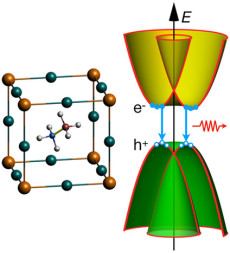A New Understanding of Perovskite Solar Cells

Strong spin-orbit coupling in halide perovskites induces splitting of the band edges, which could affect recombination rates. Image credit: X. Zhang and J.-X. Shen.
Scientific Achievement
Researchers from the University of California, Santa Barbara used NERSC supercomputers to better understand the solar conversion efficiencies of hybrid perovskites and produce critical insights into how they work.
Significance and Impact
Hybrid perovskites are spectacularly efficient materials for photovoltaics. Just a few years after the first perovskite solar cells were fabricated, they have already achieved solar conversion efficiencies greater than 22 percent. Interestingly, the fundamental mechanisms that are responsible for this high efficiency are still being vigorously debated. The results of this study showed that a frequently cited explanation, based on low radiative rates, was not viable. This now provides a sound basis for future accurate modeling and design.
Research Details
Using more than 1,000 nodes on NERSC’s Cori supercomputer, the team not only disproved one explanation for high solar cell efficiencies, but also studied how the materials could be used in light emitting diodes (LEDs). “These calculations are extremely demanding, and the compute power provided by NERSC has been instrumental in obtaining these results,” commented lead researcher Chris Van de Walle.
Additional Information
- X. Zhang, J.-X. Shen, W. Wang, and C. G. Van de Walle, "First-Principles Analysis of Radiative Recombination in Lead-Halide Perovskites"; ACS Energy Letters 3, 2329 (2018). 10.1021/acsenergylett.8b01297
- Revealing Reclusive Recombination Mechanisms in Solar Cell Materials
About NERSC and Berkeley Lab
The National Energy Research Scientific Computing Center (NERSC) is a U.S. Department of Energy Office of Science User Facility that serves as the primary high performance computing center for scientific research sponsored by the Office of Science. Located at Lawrence Berkeley National Laboratory, NERSC serves almost 10,000 scientists at national laboratories and universities researching a wide range of problems in climate, fusion energy, materials science, physics, chemistry, computational biology, and other disciplines. Berkeley Lab is a DOE national laboratory located in Berkeley, California. It conducts unclassified scientific research and is managed by the University of California for the U.S. Department of Energy. »Learn more about computing sciences at Berkeley Lab.







